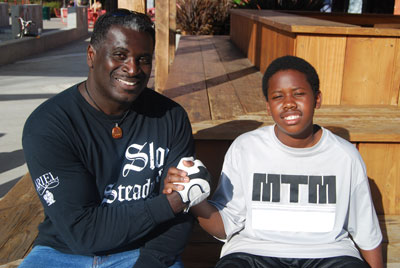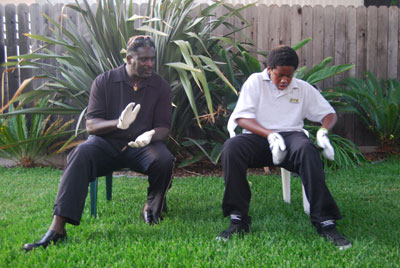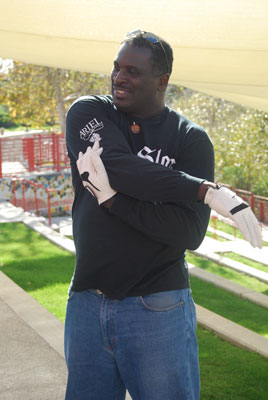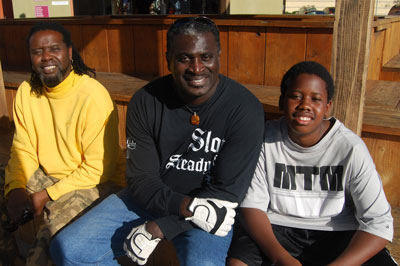Master artist Danny ‘Slapjazz’ Barber (Spring Valley) and his apprentice Sekani Thomas (San Diego) participated in ACTA’s 2009 Apprenticeship Program in an apprenticeship in hambone, or patting Juba, an African-American tradition which stems from life under slavery in the United States.
 Due to the Stono Insurrection in North Carolina in 1739, slaves were forbidden to own drums, which were a vital part of their cultural lives and highly regarded as a form of communication. Also prohibited to gather en masse due to perceived threat to the slave owners, slaves sustained drum rhythms by using their bodies, resulting in a body percussion form which merged musical expression with covert communication in a gesture of survival, defiance, ingenuity, improvisation and connectivity. Hambone at one point had coded rhythms or visual patterning which relayed information between slaves, unbeknownst to slave owners.
Due to the Stono Insurrection in North Carolina in 1739, slaves were forbidden to own drums, which were a vital part of their cultural lives and highly regarded as a form of communication. Also prohibited to gather en masse due to perceived threat to the slave owners, slaves sustained drum rhythms by using their bodies, resulting in a body percussion form which merged musical expression with covert communication in a gesture of survival, defiance, ingenuity, improvisation and connectivity. Hambone at one point had coded rhythms or visual patterning which relayed information between slaves, unbeknownst to slave owners.
Barber reflects that “it is important for people of my culture to see the beauty that rose out of oppression, and that they should take pride in the struggle that has brought us to this day.” Rife with complex cadences, hambone demands ambidexterity and a refined sense of polyrhythm and unison.
 Barber first learned at age sixteen in Florida, by his cousin Todd Barber from Georgia, who learned from their grandfather Judson Barber. When Barber was first introduced to hambone by his cousin, Barber “literally beat myself to death to master the form. To own it.” Barber describes himself as always having been a “rhythm person,” developing skill early on in hambone, in addition to developing a background as a percussionist, first starting out playing bass drum, then advancing to tenor and snare drum, and finally becoming a drum major. “Rhythm has always been a part of my life, and I’ve always wanted to harness it, to perfect it for myself. Now that I have mastered hambone, I feel the obligation to pass it on, and Sekani is a beautiful student.”
Barber first learned at age sixteen in Florida, by his cousin Todd Barber from Georgia, who learned from their grandfather Judson Barber. When Barber was first introduced to hambone by his cousin, Barber “literally beat myself to death to master the form. To own it.” Barber describes himself as always having been a “rhythm person,” developing skill early on in hambone, in addition to developing a background as a percussionist, first starting out playing bass drum, then advancing to tenor and snare drum, and finally becoming a drum major. “Rhythm has always been a part of my life, and I’ve always wanted to harness it, to perfect it for myself. Now that I have mastered hambone, I feel the obligation to pass it on, and Sekani is a beautiful student.”
During the course of the apprenticeship, which occurred in various locations in San Diego County including community centers, public spaces and Thomas’s home, Barber’s and Thomas’s goals included working to get Thomas to a degree of technical skill which would allow him to perform with Barber, as well as to inspire younger people like Thomas to recognize this tradition.
Thomas is the son of Bernard Yiriba Thomas, founder and Co-Director of Teye Sa Thiosanne African Drum and Dance Company in San Diego [alongside choreographer and Co-Director Aminisha Cunningham]. When Barber started to show Thomas hambone, Thomas took to it rapidly and proved to be a fast learner because, as Barber notes, “Sekani has a rhythm background because of his family, and can interpret music properly.”
 Drummer Yiriba Thomas agrees that his son is a “shoe-in to receive the gift which Danny can pass on to him” and feels that this practice under Barber’s direction not only keeps the tradition alive, but also benefits his son as “a precursor to math skills, mental exercises, real time sequential thinking and developing a ‘stick-to-it-ness’ in Sekani. Rhythm is multitasking – you need to think both vertically and horizontally.”
Drummer Yiriba Thomas agrees that his son is a “shoe-in to receive the gift which Danny can pass on to him” and feels that this practice under Barber’s direction not only keeps the tradition alive, but also benefits his son as “a precursor to math skills, mental exercises, real time sequential thinking and developing a ‘stick-to-it-ness’ in Sekani. Rhythm is multitasking – you need to think both vertically and horizontally.”
Barber and Yiriba Thomas see engaging Thomas as a strategy which can have benefits beyond the apprenticeship, by developing young people’s interest in hambone based on Thomas’s own progress. Yiriba Thomas says: “Sekani likes to demonstrate his ability to friends. He’s anxious already to let others know and to show others. We need to get this to Sekani’s school and to expose this form to young people, to get youth to inspire other youth.”
As an apprentice, Thomas wants to learn all the rhythms and forms of patting Juba. Barber’s own innovations and original cadences are embedded in movement phrases with names like “heart cross,” “the pop,” “the flick,” “to the top,” “roll cross,” and “roller coaster.” Yiriba Thomas describes Barber’s own development of a distinctive style as one which emerges from “a deep well of expression, coming from the spirit and the soul.” An apprenticeship goal is to instill Barber’s Slapjazz style and technique—inclusive of timing, execution, coordination, logic, sequential thinking, and focus—solidly in Thomas, to “pass it onto Sekani so that the form will live on when I’m gone,” says Barber. “It’s hard to make him stop!”
During the course of one lesson, Barber demonstrates his technique and tells Thomas to “Conserve your energy. Extend your creativity.” This direct statement exemplifies the very spirit of survival and expansive improvisation within this form.
Yiriba Thomas links contemporary hambone and its values back to its origins: “The patting Juba tradition speaks of ‘Making the way out of no way.’ There are inherent lessons of life in wading through difficult matter. Sekani is now sitting at the foot of Danny. This apprenticeship is a reaching out to Sekani which will provide the vehicle for his consciousness.”

